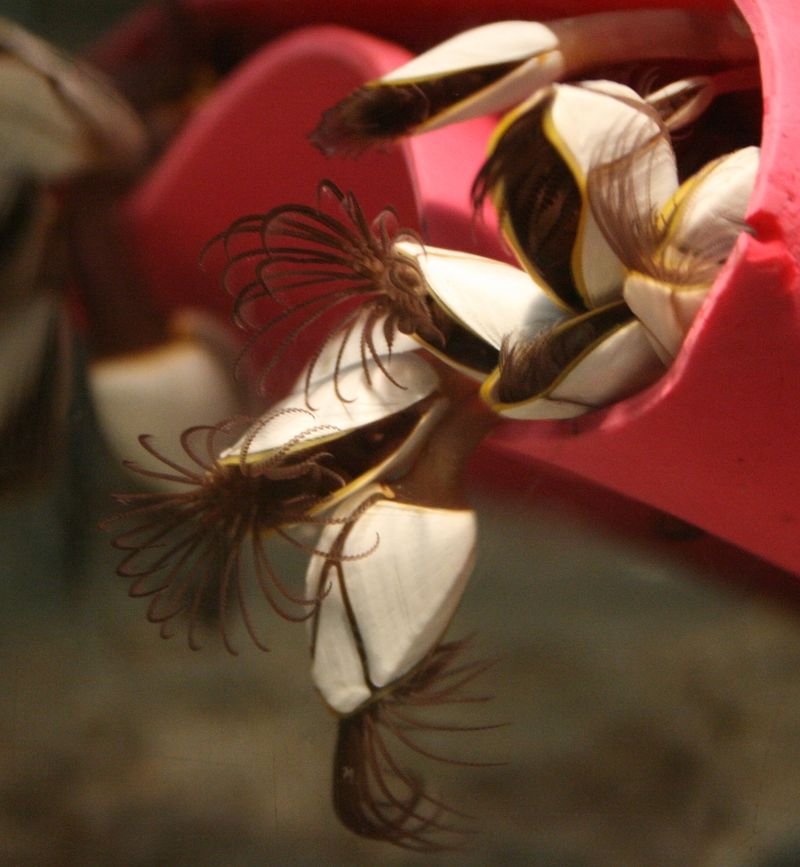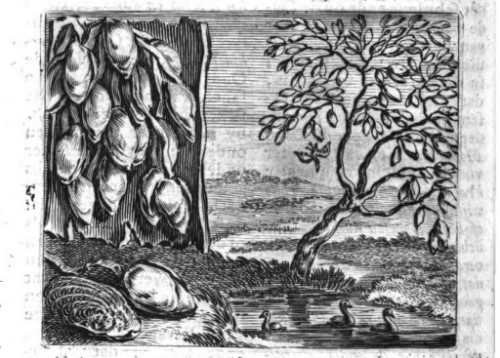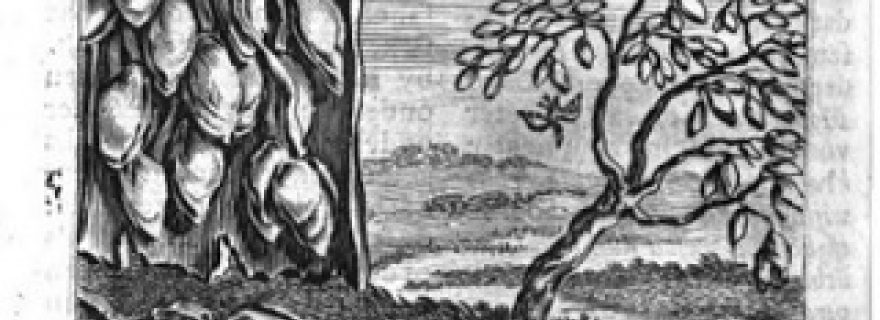Goose barnacle and barnacle goose
Early Modern Natural historians often referred to other texts of natural history, and in doing so they included unreliable knowledge. An example is the genesis of geese out of Pedunculata shells, a so-called spontaneous generation.
_(1).jpg)
Fig. 1 Gooseneck Barnacles (Lepas anatifera) Source: Michel Estermann
The origins of natural objects play an important role in the description of objects in G. E. Rumphius’ Curiosity Cabinet (Amsterdam 1705). Natural historians oftentimes hotly debated the origins of objects. To prove their theories, natural historians referred to other authors and texts of natural history. In doing so, they included contradictory views that were in the text itself marked as outdated or unreliable knowledge. An example is the genesis of geese out of Pedunculata shells, a so-called spontaneous generation.
Earlier on this blog Sophia Hendrikx, specialized in ichthyology books, talked about Spontaneously Generating Fish. In the Classical Era and the Middle Ages, the idea of spontaneous generation – the development from life out of the inanimate – was an accepted theory about the generation of life. Conrad Gessner in his Historia animalium (1551–1558) adheres to the theory of sexual reproduction, but he does not completely rule out the possibility of spontaneous generation. In the course of the Early Modern Period, doubts about the theory of spontaneous generation arose. These doubts are also expressed in the Curiosity Cabinet.

Fig. 2 Goose Barnacle in EcoMare (Texel, NL) Source: M. Buschmann
In the entry on the oyster species Longnecks (Langhalsen), Rumphius cites a text fragment of Jacobus Lydius’ Vrolyke Uren, ofte Der wysen Vermaeck (Dordrecht: Hendrik van Esch, 1650). The quote expresses the idea that geese, co-called branten, (in the Curiosity Cabinet Kranten or Schotsche Rotgansen) originate in an oyster subspecies. Following the modern nomenclature, we are dealing here with Barnacle goose (Branta leucopsis). The idea of spontaneous generation left its traces in the modern name for the shells: in English they are called goose barnacle (in German and Dutch, it is the duck, not the goose: Entenmuscheln in German; Eendenmosselen in Dutch). Because the phenomenon of bird migration was not known and nobody had seen nests or chicks of this species, spontaneous generation seemed a plausible explanation.
The ones that the oft quoted Mr. Colvius has, are like little Mussels, that hang from seaweed, which is stuck onto a piece of wood, wherefrom one has thought, that birds do grow, because one will find a substance inside those Mussel shells (which are of a white color, which is why they are called Oysters by others), that looks very like the feathers of the tail, or wing of a small bird, that is fastened onto the edges of the Oyster or Mussel with a thin little skin, which I noted myself after I opened one; and on the side where the Mussel is stuck to the seaweed, one will see another substance, which appears to be the body of some creature; but one will not find there the true shape of a little bird, nor the beak, nor its head. (CC II, 37, p. 218; based on Jacobus Lydius: Vrolyke Uren des Doods, ofte der wysen Vermaek. 1750, p. 88)
In the quote, some doubts about the genesis of geese out of shells are present. The narrator in Lydius’ Vrolyke Uren cannot confirm the theory after having examined the shells himself. He accounts of having received some shells from Mr. Clovius – who we can assume is Andreas Clovius, a preacher and collector from Dordrecht (Jorink 2007, 304). In the illustration, which, as the narrator remarks, is based on Clovius’ shells, two theories are combined: the genesis of geese out of shells (left) and the growing of geese on trees (right). The narrator of the Vrolyke Uren regards the last theory as unlikely, “minst waerschijnlijk” (Lydius: Vrolyke Uren, p. 81).

Fig. 3 Illustration of barnacle geese (branten) Source: Jacobus Lydius: Vrolyke Uren des Doods (1750), p. 80. Held in the Universiteits Bibliotheek Gent, BIB.BL.008108.
The examination of the shells by the narrator is not the only thing casting doubt on the spontaneous generation of geese. He also dissected the birds, finding eggs within. Based on these examinations he discusses the genesis of geese out of eggs.
The Curiosity Cabinet dismisses the idea of the spontaneous generation of geese right after the quote of De Vrolyke Uren:
It has been sufficiently discovered during the journey of the Dutch to the North, that the Wild Geese have been found brooding on their eggs in the Northern regions, such as Greenland and Nova Zembla, and from there they fly to the Southlands every year. (CC II, 37, p. 218)
The nesting of barnacle geese on Nova Zembla was already described in 1598: “The first true account of the nesting of barnacle geese is found in Gerrit de Veer, Diarium nauticum, seu vera descriptio trium navigationum admirandum (Amsterdam, 1598)” (Hoeniger 1985, 146). He refers to Gerrit de Veers description of three voyages, which includes the famous winter spent trapped on Nova Zembla: Waerachtige beschryvinghe van drie seylagien, ter werelt noyt zo vreemt ghehoort.
Why did Rumphius not choose to directly include a quote about the genesis of geese out of eggs, presenting it only after a view he seems to reject?
In the inclusion of different opinions, referencing and quoting numerous authors and texts, I detect what Richard Nate, based on research of early modern scientific texts, calls the norm of completeness (Nate 2009, 121). The report of an out-dated theory is part of an argument and reflects the process of opinion forming. As Harold J. Cook remarks: “Evaluation worked by checking a proposition against other kinds of information” (Cook 2013, 38). The origin theory also provides an amusing anecdote that increases the value of the shell as collectable as well as the entertainment while reading. The description of the object itself turns into a curiosity and a collectable. The reference to the spontaneous generation of geese also provides an explanation for the name Longnecks.
However, not all parts of the description of the geese in the Vrolyke Uren are included in the Curiosity Cabinet. The moral-allegoric implication is left out. The entry about the branten in De Vrolyke Uren ends as follows: Just like the phoenix, whose possible existence is discussed right before the branten, the geese according to the Jesuit Nicolaus Caussinus are “een beeltenisse […] van de opstandinge der dooden” (p. 89; an image of the resurrection of the dead). The Curiosity Cabinet does not connect the spontaneous generation with the Christian concept of resurrection. This can be explained by the differences between the genres. Lydius’ Vrolyke Uren is Christian devotional literature. The phoenix and the branten serve as examples. While comprehensive arguments for and against the spontaneous generation of branten are discussed, the truth about the origin is of secondary importance. The Curiosity Cabinet is a text of natural history. The reference to spontaneous generation serves as an anecdote and reproduces the reasoning that leads to Rumphius’ view on the origin of geese. Because there is no connection between the Christian concept of resurrection and the spontaneous generation in the Curiosity Cabinet, spontaneous generation as a theory of origin can be dismissed.
Sources
Rumphius, Georgius E.: D’Amboinsche rariteitkamer: behelzende eene beschryvinge van allerhand zoo weeke als harde schaalvisschen, te weeten raare krabben, kreeften, en diergelyke zeedieren, als mede allerhande hoorntjes en schulpen, die men in d’Amboinsche Zee vindt: daar beneven zommige mineraalen, gesteenten, en soorten van aarde, die in d’Amboinsche, en zommige omleggende eilanden gevonden worden. Amsterdam: François Halma, 1705. Digitization by the Göttingen State and University Library http://resolver.sub.uni-goettingen.de/purl?PPN372428037
Rumphius, Georgius E.: The Ambonese Curiosity Cabinet. Transl., ed., annotated, and with an introd. by E. M. Beekman, New Haven: Yale Univ. Press 1999.
Lydius, Jacobus et al.: Vrolyke Uren des Doods, ofte der wysen Vermaek. Dordrecht: Abraham Blusse en Jakobus van Hoogstraeten, 1750. Digitization by the University of Gent. http://lib.ugent.be/en/catalog/bkt01:000150157?i=0&q=Vrolyke+uren+des+doods
Literature
Nate, Richard. 2009. Wissenschaft, Rhetorik und Literatur: historische Perspektiven. Würzburg: Königshausen & Neumann.
Hoeniger, F. David. 1985. “How Plants and Animals Were Studied in the Mid-Sixteenth Century.” In Science and the Arts in the Renaissance, edited by John W. Shirley und F. David Hoeniger, 130-148. Washington/London/Toronto: Associated University Presses.
Jorink, Eric. 2007. Het Boeck der Natuere: Nederlandse geleerden en de wonderen van Gods schepping, 1575 – 1715. Leiden: Primavera Pers.
Cook, Harold. 2013. Assessing the Truth. Correspondence and Information at the End of the Golden Age. Leiden: Primavera Pers.
This post also appeared on Rumphius.



0 Comments